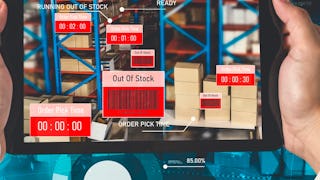In the Implementing Supply Chain Analytics: Descriptive, Diagnostic, Predictive and Prescriptive course, you’ll discover how implementing analytical methods, models, and tools helps decision-making become more efficient. You’ll use different types of methods, models, and tools, depending on specific business scenarios or needs, to help you analyze the current state of the supply chain and to lead you to insightful solutions. You’ll also explore the utilization of supply chain models to evaluate and question the data to optimize the flow of goods, information, and cost in a supply chain to help identify potential improvements, determine the most efficient or practical course of action, and to communicate the impact to the customer.


Implementing Supply Chain Analytics
This course is part of Unilever Supply Chain Data Analyst Professional Certificate

Instructor: Unilever Team
6,490 already enrolled
Included with
(58 reviews)
Recommended experience
Skills you'll gain
- Python Programming
- Supply Chain
- Data-Driven Decision-Making
- Data Presentation
- Inventory and Warehousing
- Data Storytelling
- Analytics
- Technical Communication
- Supply Chain Systems
- Statistical Reporting
- SQL
- Forecasting
- Business Analytics
- Supply Chain Planning
- Supply Chain Management
- Predictive Analytics
- Data Analysis
- Advanced Analytics
- Descriptive Analytics
Details to know

Add to your LinkedIn profile
19 assignments
See how employees at top companies are mastering in-demand skills

Build your Data Analysis expertise
- Learn new concepts from industry experts
- Gain a foundational understanding of a subject or tool
- Develop job-relevant skills with hands-on projects
- Earn a shareable career certificate from Unilever

There are 4 modules in this course
In this module, you will learn how programming languages such as Python and SQL assist in managing, cleaning, summarizing and manipulating data.Communicating Diagnostic Analytics You will also learn how to use programming languages to create meaningful data visualizations.
What's included
16 videos6 readings3 assignments1 discussion prompt1 plugin
Data analytics is the practice of examining data to answer questions, identify trends, and extract insights. In this module, you will focus on the four levels of data anlytics that help answer questions about what happened and why, what might happen in the future, and what are the possible outcomes.
What's included
15 videos11 readings6 assignments1 discussion prompt
There are several different types of Supply Chain models. Once you know the probem your trying to solve, you can select the type of model that will best help you find a solution. In this module you will learn how use the inventory model to describe inventory policies, inputs and outputs, operations related to inventory management, how to use the continuous flow model to describe the current state and current practices in the business operations to identify opportunities for improvement, and how to use the fast chain model to describe the current state and current practices in the business operations to identify opportunities for improvement.
What's included
11 videos5 readings4 assignments
There are several different types of Supply Chain models. Once you know the probem your trying to solve, you can select the type of model that will best help you find a solution. In this module you will learn how use the efficient chain model to identify optimal scenarios and best practices that could be translated into other environments, use the agile model to prepare for participating in cross-functional developments driven by the supply chain, use the custom-configured model to prepare cross-functional developments driven by the supply chain with a more flexible infrastructure to new projects or developments, and use the flexible model to build flexible structures and scenario planning.
What's included
7 videos22 readings6 assignments1 plugin
Earn a career certificate
Add this credential to your LinkedIn profile, resume, or CV. Share it on social media and in your performance review.
Instructor

Offered by
Explore more from Data Analysis
 Status: Free Trial
Status: Free Trial Status: Free Trial
Status: Free Trial Status: Free Trial
Status: Free TrialRutgers the State University of New Jersey
 Status: Free Trial
Status: Free TrialRutgers the State University of New Jersey
Why people choose Coursera for their career




Learner reviews
58 reviews
- 5 stars
82.75%
- 4 stars
8.62%
- 3 stars
3.44%
- 2 stars
3.44%
- 1 star
1.72%
Showing 3 of 58
Reviewed on Nov 25, 2025
its was good but can also add more pratical questions
Reviewed on Jul 22, 2024
This was also really informative, it has led me to want to go more into learning Python and SQL, this course was a real good introduction and quite good in how it was curated.

Open new doors with Coursera Plus
Unlimited access to 10,000+ world-class courses, hands-on projects, and job-ready certificate programs - all included in your subscription
Advance your career with an online degree
Earn a degree from world-class universities - 100% online
Join over 3,400 global companies that choose Coursera for Business
Upskill your employees to excel in the digital economy
Frequently asked questions
To access the course materials, assignments and to earn a Certificate, you will need to purchase the Certificate experience when you enroll in a course. You can try a Free Trial instead, or apply for Financial Aid. The course may offer 'Full Course, No Certificate' instead. This option lets you see all course materials, submit required assessments, and get a final grade. This also means that you will not be able to purchase a Certificate experience.
When you enroll in the course, you get access to all of the courses in the Certificate, and you earn a certificate when you complete the work. Your electronic Certificate will be added to your Accomplishments page - from there, you can print your Certificate or add it to your LinkedIn profile.
More questions
Financial aid available,

